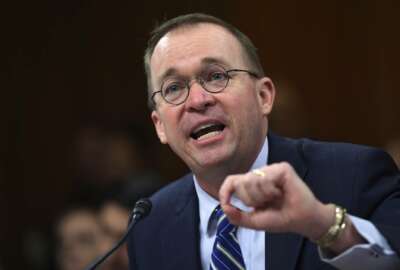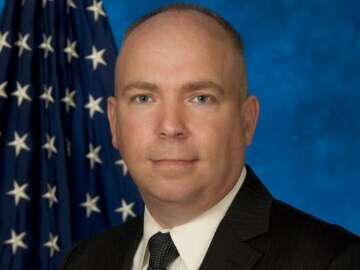
Education’s body and soul approach to IT modernization
Jason Gray, the Education Department’s chief information officer, said IT modernization is all about making both the policy and the infrastructure more flexible,...
Best listening experience is on Chrome, Firefox or Safari. Subscribe to Ask the CIO’s audio interviews on Apple Podcasts or PodcastOne.
Register today for the Oct. 10 Ask the CIO online chat with Education CIO Jason Gray.
When it comes to IT modernization, the Education Department is addressing both body and soul, so to speak.
Education’s body is the actual technology infrastructure.
And its soul is the policy that governs that infrastructure.
Jason Gray, the Education Department’s chief information officer, said IT modernization is all about making both the policy and the infrastructure more flexible, agile and customer focused.
“Our strategy is not just about IT. I know it’s about IT modernization, but the first part of our strategy was getting support. You need to have support for your strategy and you start internally. I have a really solid, excellent team that have become modernization evangelists, and then working with the secretary and deputy secretary, both of them have been extremely supportive of our modernization efforts, our roadmap and where we are going. I give regular updates to both of them several times a month,” Gray said on Ask the CIO. “Then from there, there are the principle offices and working with them to make sure they are aware of what we are doing from a strategy and modernization standpoint because they are the consumers of the services we are talking about modernization.”
Gray said gathering input and support from the CXO community—the CFO, the chief acquisition officer, the chief human capital officer—is the other key set of stakeholders that are all in.
Gray fully understands that the first three rules of IT modernization are: communicate, communicate and then communicate again.
It took some time to create the necessary support, particularly from the program offices which will feel the greatest impact of the changes.
“There is some apprehension and a lot of questions that come up right away is ‘how are we going to do that,’” Gray said. “The reality is we need to partner with the system owners and stakeholders to make sure we do it in a way that provides the services that they actually need and the business value.”
At the same time, Gray said Secretary Betsy DeVos wants his office to move more aggressively, asking if it’s possible to reduce the number of systems Education manages not just by its goal of more than 100, but getting an even further reduction.
“It was more of the efficient and effective use, meaning do we need absolutely all of these systems. When we looked at it, the answer was we don’t. As of now as we transition over the next five years, our plan is to reduce our systems by over 100 systems and we have 284 systems today,” he said. “Our next step is we are actually doing principle office by principle office visits. We have detailed diagrams that show specifically what happens from the current state to the to-be state from a modernization standpoint.”
With that support in place, Gray and his office can get to work on the actual technology and policy changes needed.
Under the policy initiative, Gray said he’s updating all of Education’s cybersecurity documents. Instead of creating one overarching cyber policy for the entire department, Gray said he’s borrowing a page from the Defense Department where there is an overarching policy framework with a series of instructions and standards underneath it.
“What that allows us to do is be more agile as technology and security changes specifically we can adapt quicker instead of having to implement policy and wait for the process to be completed,” he said. “We also have our IT investment management policy we are updating by the end of this year. That is more of a streamlined approach. We also have an enterprise program review framework from a total governance standpoint that we are modernizing.”
On the technology side, Gray said Education is developing an approach to modernize its financial management system, which includes decoupling it from the grants management system and deciding whether a shared services platform makes sense.
Related to that effort is the continued consolidation of Education’s cloud sprawl. Gray said an analysis found 25 different cloud vendors.
“I understand how the cloud sprawl happened. In the past, you had a principle office that needed a service, the IT organization couldn’t provide that service so it was easier to get it somewhere else,” he said. “We’ve changed that. We’ve said you have to come through the CIO’s office, which is good. It doesn’t necessarily mean we will not allow another cloud service provider, but it gives us an opportunity from an enterprise view to make sure we are making those decisions informed.”
Gray said the Enterprise Infrastructure Solutions (EIS) contract from the General Services Administration also will play a big role in the department’s network modernization. He said Education is interested in software-defined wide-area network, LTE and broadband to let the agency shift from a fixed bandwidth to a consumption-based network management.
One big challenge every agency faces is how to pay for IT modernization efforts. Gray said Education used cost models under the Monte Carlo approach to determine which efforts will be most impactful.
“The key thing we want to do upfront is by providing small, quick wins so perhaps they will be low cost or no cost,” he said. “We want to demonstrate the value of the modernization efforts and then the need to invest will come from the cost savings. We’ve also looked at leveraging TMF piece of the Modernizing Government Technology Act. We have several projects teed up, but we have not submitted them yet.”
Copyright © 2025 Federal News Network. All rights reserved. This website is not intended for users located within the European Economic Area.
Jason Miller is executive editor of Federal News Network and directs news coverage on the people, policy and programs of the federal government.
Follow @jmillerWFED
Related Stories





